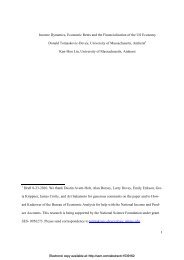Corporate governance and firm valuation
Corporate governance and firm valuation
Corporate governance and firm valuation
Create successful ePaper yourself
Turn your PDF publications into a flip-book with our unique Google optimized e-Paper software.
412 L.D. Brown, M.L. Caylor / Journal of Accounting <strong>and</strong> Public Policy 25 (2006) 409–434<br />
identify five internal <strong>governance</strong> factors that are related to <strong>firm</strong> value, exp<strong>and</strong>ing<br />
dramatically our knowledge of the number of internal <strong>governance</strong> factors<br />
linked to <strong>firm</strong> value beyond the sole (shareholder activism) variable suggested<br />
by Cremers <strong>and</strong> Nair (2005). 5 Third, we document that five accounting based<br />
<strong>governance</strong> provisions are not positively related to <strong>firm</strong> value. Fourth, using<br />
a different database, time period <strong>and</strong> methodology than past research, we con<strong>firm</strong><br />
past evidence that absence of a staggered board <strong>and</strong> a poison pill are significantly<br />
<strong>and</strong> positively associated with <strong>firm</strong> <strong>valuation</strong>, enhancing the validity<br />
that these corporate <strong>governance</strong> provisions are linked to <strong>firm</strong> value (Bebchuk<br />
et al., 2005). Fifth, our evidence enhances the validity of the Bebchuk et al.<br />
(2005) findings that only a small fraction of <strong>governance</strong> factors marketed by<br />
database providers are relevant for <strong>firm</strong> value. 6 Sixth, we create a summary <strong>governance</strong><br />
measure (Gov-Score) that is better linked to <strong>firm</strong> value than the oftused<br />
G-Index. Moreover, relative to G-Index, Gov-Score is broader in scope,<br />
represents both internal <strong>and</strong> external <strong>governance</strong> measures, applies to more<br />
<strong>firm</strong>s, <strong>and</strong> is more dynamic than Bebchuk et al.’s entrenchment index. 7<br />
We proceed as follows. Section 2 discusses related research, <strong>and</strong> Section 3<br />
describes our data <strong>and</strong> methodology. Section 4 relates Gov-Score to <strong>firm</strong> <strong>valuation</strong>.<br />
Section 5 uses three econometric approaches to ascertain which <strong>governance</strong><br />
factors drive the relation between Gov-Score <strong>and</strong> <strong>firm</strong> <strong>valuation</strong>. Section 6 derives<br />
an index (Gov-7) based on seven ISS factors, <strong>and</strong> shows that it fully drives the relation<br />
between Gov-Score <strong>and</strong> <strong>firm</strong> <strong>valuation</strong>. Section 7 contains the results of three<br />
additional analyses, Section 8 contains discussion, <strong>and</strong> Section 9 summarizes.<br />
2. Review of related research<br />
Prior research has linked corporate <strong>governance</strong> to <strong>firm</strong> <strong>valuation</strong> using<br />
Tobin’s Q as a proxy for <strong>firm</strong> <strong>valuation</strong>. 8 Early studies examined links between<br />
5 Recent evidence suggests that shareholder activists may not enhance <strong>firm</strong> value. Nelson (2006)<br />
shows that the announcement of targeting by one of the largest shareholder activist groups, the<br />
California Public Employees’ Retirement System, is not associated with significant positive<br />
abnormal returns.<br />
6 Bebchuk et al. show that only 25% of the IRRC factors fully drive the relation between G-Index<br />
<strong>and</strong> <strong>firm</strong> <strong>valuation</strong>. We show that approximately 14% of the ISS factors fully drive the relation<br />
between Gov-Score <strong>and</strong> <strong>firm</strong> <strong>valuation</strong>.<br />
7 As described in Section 3 below, the 51 ISS measures span eight categories of corporate<br />
<strong>governance</strong>, six categories are primarily internal <strong>and</strong> two are external. In contrast, the 24 IRRC<br />
measures generally are confined to the two ISS categories of external <strong>governance</strong>. ISS has complete<br />
data on 2538 <strong>firm</strong>s as of February 1, 2003. In contrast, IRRC has complete data on 1983 <strong>firm</strong>s as of<br />
its latest year, 2004.<br />
8 Rather than provide a review of the vast corporate <strong>governance</strong> literature, we discuss those<br />
studies most relevant to <strong>firm</strong> <strong>valuation</strong>. See Shleifer <strong>and</strong> Vishny (1997), John <strong>and</strong> Senbet (1998) <strong>and</strong><br />
Hermalin <strong>and</strong> Weisbach (2003) for literature reviews.







